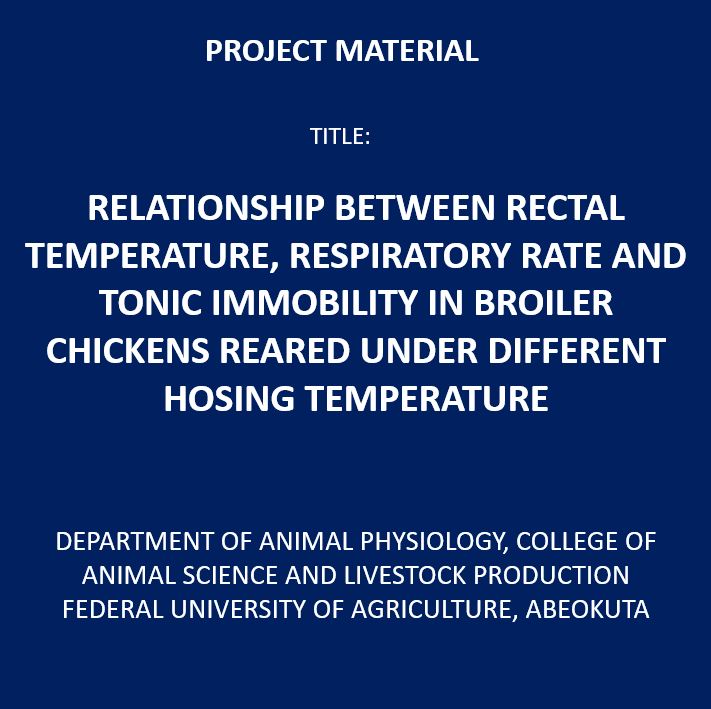No products in the cart.
Relationship Between Rectal Temperature, Respiratory Rate and Tonic Immobility in Broiler Chickens Reared Under Different Hosing Temperature
₦10,150.00
RELATIONSHIP BETWEEN RECTAL TEMPERATURE, RESPIRATORY RATE AND TONIC IMMOBILITY IN BROILER CHICKENS REARED UNDER DIFFERENT HOSING TEMPERATURE
- PROJECT YEAR: 2016
- NUMBER OF PAGES: 24
- FILE TYPE: PDF
- DEGREE: BACHELOR
- DEPARTMENT: DEPARTMENT OF ANIMAL PHYSIOLOGY, COLLEGE OF ANIMAL SCIENCE AND LIVESTOCK PRODUCTION FEDERAL UNIVERSITY OF AGRICULTURE, ABEOKUTA
INTRODUCTION
For the rapidly increasing human population in Nigeria, broiler production plays a major role in food security. This can be attributed to their short production cycle, and high feed efficiency and growth rate. However, compared to other domestic animals, broiler chickens are more susceptible to changing housing temperature mostly during growing-finishing phase (Abioja, 2010). This is because they have rapid metabolism, high body temperature and no sweat gland.
Yahav (2000) discovered that success in breeding for high growth rate in broilers has resulted into inferior development of their cardio-vascular and respiratory systems which predispose them to heat-stress. These physiological characteristics, in combination with confined housing make it
difficult for broilers to regulate their heat balance.
Heat stress is a condition caused by high environmental temperature and relative humidity which reduces heat loss and consequently results in the accumulation of heat when there is increase in core body temperature (Jensen and Toates, 1997). The effect of high environmental temperature
on the general health and productivity has been of great concern for a long time. Rocha et al. (2010) revealed that the thermal comfort inside poultry house is a very important factor, since weather conditions can adversely affect the inadequate production of broilers. With the rapid development of the poultry industry worldwide, especially in developing countries, importation of temperature-zone high performance stocks to hot regions is on the increase (Yalcin et al., 1997).
At high ambient temperature, growth decreases as a result of the reduced appetite, feed intake and respiratory increases. To get the most productivity in poultry production, it is essential that the thermal environment presents appropriate comfort levels, allowing broilers to express their maximum genetic potential. When housing temperature inside a poultry house are out of the comfort limits, the environment becomes uncomfortable, requiring the animal body (below 20oC) physiological adjustment to maintain homeothermy, be it to retain or dissipate heat. As the thermal environment becomes increasingly stressful, the animal body perceives the risk of life and ceases to prioritize production and reproduction, focusing only on their survival. The main effects of exposure of homeothermic animals to heat are changes in the rectal temperature.
Rectal temperature can be considered the best criterion to judge heat tolerance and it is an important efficiency indicator in the homeothermy maintenance facing the thermal environment (Garaert et al., 1996). Rectal temperature can also be used to assess heat stress impacts. Rectal temperature is the temperature measure by a clinical thermometer placed in the rectum of a broiler. The average rectal temperature of broiler chickens is around 41.5°C, ranging from 40.6 to 43.0°C.
An increase in ambient temperature beyond the thermo-neutral zone of birds causes birds to start panting as a physiological mechanism for controlling body temperature. Increased respiratory rate (Shane, 1988) and rectal temperature (Altan et al., 2000) has been observed as major physiological indicators of heat-stress. When ambient temperature rises above the thermo-neutral zone of the birds, non-evaporative cooling declines while evaporative cooling becomes the
principal heat dissipation route. Panting occurs when the deep body temperature of the bird reaches 41-43oC. In normal birds, panting will remove approximately 540 calories per g water lost by the lungs (Butcher and Miles, 2003). There may also be an increase in respiratory rate from 25 to 150 breaths per minute over a 20-minute period in response to an increase in ambient temperature from 27-44oC (Shane, 1988).
Fear is an adaptive behavior whose biological role is to protect the animal from psychochemical damage. It is defined as a reaction to the perception of actual danger (Forkman et al., 2007). The increased intensity of fear response can have deleterious consequences on poultry welfare and performance (Faure et al., 2003). One of the most commonly used fear test is tonic immobility elicited by natural restraint, while others are open field, noel object etc. A number of studies support the notion that under natural condition, tonic immobility serves in the capacity of predator defense (Gallup et al., 1971; Ratner et al., 1967). According to Faure et al., 2003, the increase intensity fear response can have deleterious consequences on poultry welfare and performances.
No product has been found!
